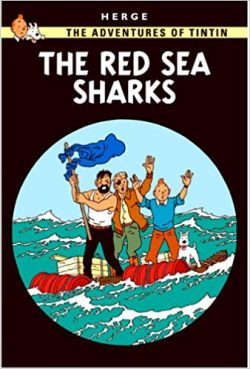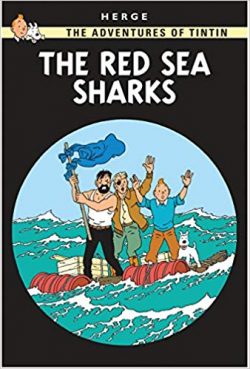

By Hergé, Bob De Moor, Roger Leloup and others, translated by Leslie Lonsdale-Cooper & Michael Turner (Egmont UK)
ISBN: 978-1-40520-818-5 (HB) 978-140520-630-3 (TPB)
Georges Prosper Remi, known all over the world as Hergé, created a timeless masterpiece of graphic literature with his tales of a plucky boy reporter and entourage of iconic associates.
Singly, and later with assistants including Edgar P. Jacobs, Bob de Moor and other supreme stylists of the Hergé Studio, he created 23 splendid volumes (originally serialised in instalments for a variety of newspaper periodicals) which have grown beyond their pop culture roots to attain the status of High Art.
On leaving school in 1925, Remi worked for the conservative Catholic newspaper Le Vingtiéme Siécle where he fell under the influence of its Svengali-esque editor Abbot Norbert Wallez. A devoted boy scout, a year later the artist produced his first strip series The Adventures of Totor for monthly Boy Scouts of Belgium magazine. By 1928 he was in charge of producing the contents of the newspaper’s weekly children’s supplement Le Petit Vingtiéme.
While illustrating The Adventures of Flup, N̩nesse, Poussette and Cochonette Рwritten by the staff sports reporter РWallez asked Remi to create a new adventure series. Perhaps a young reporter who roamed the world, doing good whilst displaying solid Catholic values and virtues?
The rest is history…
Some of that history is quite dark: During the Nazi Occupation of Belgium, Le Vingtiéme Siécle was closed down and Hergé was compelled to move his supremely popular strip to daily newspaper Le Soir (Brussels’ most prominent French-language periodical, and thus appropriated and controlled by the Nazis).
He diligently toiled on for the duration, but following Belgium’s liberation was accused of collaboration and even being a Nazi sympathiser. It took the intervention of Belgian Resistance war-hero Raymond Leblanc to dispel the cloud over Hergé, which he did by simply vouching for the cartoonist. Leblanc also provided cash to create a new magazine – Le Journal de Tintin – which he published and managed. The anthology comic swiftly achieved a weekly circulation in the hundreds of thousands, which allowed the artist and his team to remaster past tales: excising material dictated by the occupiers and unwillingly added to ideologically shade the war time adventures. The modernising exercise generally improved and updated the great tales, just in time for Tintin to become a global phenomenon.
With World War II over and his reputation restored, Hergé entered the most successful period of his artistic career. He had mastered his storytelling craft, possessed a dedicated audience eager for his every effort and was finally able to say exactly what he wanted in his work, free from fear or censure. Although Hergé’s later life was plagued by personal and health problems, this only seemed to enhance his storytelling abilities.
Coke en stock began initial serialisation in Le Journal de Tintin from 31st October 1956 and on completion (1st January 1958) issue was collected into album form. In 1960 it voyaged across the channel to become The Adventures of Tintin: The Red Sea Sharks: a slick, perfectly polished comedy thriller, rife with intrigue and camaraderie. Even after decades it reads as a fresh and challenging romp ideal for young and old alike.
The Red Sea Sharks has lost none of its original contemporary urgency. Produced during the turbulent times that led to the Middle Eastern Suez Crisis, it remains worryingly relevant with nations and mad millionaires carrying out proxy wars amidst the sand dunes and shipping lanes…
The yarn reintroduces Emir Ben Kalish Ezab (from Land of Black Gold) whose oil-rich country is in the throes of a civil war manufactured by the moneyed powers of the West. Fearful of the consequences, the hard-pressed potentate sends his son Abdullah to stay with Captain Haddock at rural Marlinspike Hall, unaware that the old dipsomaniac and Tintin are currently embroiled in a minor mystery involving former south American dictator General Alcazar (The Broken Ear), cheap war surplus aircraft and a hidden criminal mastermind…
As eager to escape the infernal practical jokes of the incorrigible Prince Abdullah as to solve the case, the heroic pair trace the trail of the sinister arms dealers and soon find themselves back in the Desert Kingdom of Khemed.
The Europeans are closely monitored and arrive as unwelcome intruders after the rebels defeat the Emir and drive him into hiding, thanks to their illicitly gained fighter planes. When a hidden bomb leaves Tintin’s plane wrecked in the wastelands, the indomitable pair trek overland into enemy territory before finally finding the Emir-in-hiding.
Here they learn the coup has been instigated by the Marquis di Gorgonzola, an enigmatic self-made millionaire whose vast commercial interests are supplemented by selling into slavery pilgrims undertaking the Hajj to Mecca!
Hot on the trail, the pair take ship for that holy city but are strafed by warplanes. Shooting one down they rescue the pilot, but when they and their new-found ally are rescued by Gorgonzola’s yacht, Tintin discovers that one of his oldest foes is behind it all…
This spectacular high-adventure, despite its political and moral underpinnings, is primarily an action yarn with plenty of twists and turns and a terrific feel-good climax.
The Red Sea Sharks: artwork © 1958, 1986 Editions Casterman, Paris & Tournai. Text © 1960 Egmont UK Limited. All Rights Reserved.
